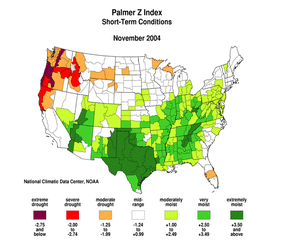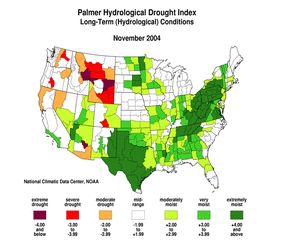U.S. Drought Highlights:
- On the national scale, severe to extreme drought affected about 4 percent of the contiguous United States as of the end of November 2004.
- Moderate to extreme drought affected about 8 percent of the contiguous U.S.
- November was dry across the Pacific Northwest, northern Rockies, northern Plains, and most of Florida.
- Much of the southwestern U.S. drought region was wetter than normal for the third month in a row, effectively ending the drought in some areas according to the Palmer Hydrological Drought Index.
- Long-term moisture deficits (last 24 to 36 to 60 months) persisted across much of the West into the northern High Plains and central Plains.
Please Note: The data presented in this drought report are preliminary. Ranks, anomalies, and percent areas may change as more complete data are received and processed.
National Overview
On the national scale,
- severe to extreme drought affected about 4 percent of the contiguous United States as of the end of November 2004, a decrease of about 1 percent compared to last month
- about 8 percent of the contiguous U.S. fell in the moderate to extreme drought categories (based on the Palmer Drought Index) at the end of November
- on a broad scale, the last two decades were characterized by unusual wetness with short periods of extensive droughts, whereas the 1930s and 1950s were characterized by prolonged periods of extensive droughts with little wetness
- about 29 percent of the contiguous U.S. fell in the severely to extremely wet categories at the end of November
- a file containing the national monthly percent area severely dry and wet from 1900 to present is available
- historical temperature, precipitation, and Palmer drought data from 1895 to present for climate divisions, states, and regions in the contiguous U.S. are available at the Climate Division: Temperature-Precipitation-Drought Data page in files having names that start with "drd964x" and ending with "txt" (without the quotes).
Regional Overview
November was dry across the Pacific Northwest, northern Rockies, northern Plains, and most of Florida. But much of the southwestern U.S. drought region was wetter than normal for the third month in a row, effectively ending the drought in some areas according to the Palmer Hydrological Drought Index.
The November precipitation pattern at the primary stations in Alaska was mixed. In Hawaii, most of the primary stations in the southern islands were drier than normal, while the northern islands were mostly wetter than normal. The pattern in Puerto Rico was drier than normal in the southwest and wetter than normal in the northeast, based on National Weather Service radar estimates of precipitation and on Cooperative station precipitation reports for the last 4 weeks and 8 weeks. November streamflow averaged near normal for Hawaii and Puerto Rico.
Dryness was evident at the 2 month to 3 month timescales across parts of Florida, the Pacific Northwest, northern Rockies, southern Great Lakes, and northern New England.
Long-term moisture deficits persisted in many areas. Much of the central and northern Rockies were dry at the 9 to 24 month timescales. Many Alaska stations were drier than normal at the 12 month timescale. Severe moisture deficits were evident at the 36 to 60 month timescales across much of the West into the northern High Plains and central Plains. These long-term hydrological drought conditions are reflected in the November 30 United States Drought Monitor map.
Some regional highlights:
- End-of-month and monthly averaged soil moisture conditions were drier than normal across parts of Wyoming and Montana, the Pacific Northwest, eastern Alaska, and near the surface and at depth from the central Plains to the Great Lakes, based on model computations (CPC-1, CPC-2, MRCC).
- Streamflow levels were below seasonal norms across parts of the West, central Plains, and Great Lakes, both as computed by models and based on USGS observations.
- Reservoir levels in most of the western states continued well below seasonal normals. Although long-term (out to 5-years) moisture conditions remained dry across much of the West, drought conditions have improved in recent months. The percent area of the western U.S. (Rockies westward) experiencing moderate to extreme drought (as defined by the Palmer Drought Index) decreased to about 15%.
 NOAA's National Centers for Environmental Information
NOAA's National Centers for Environmental Information

